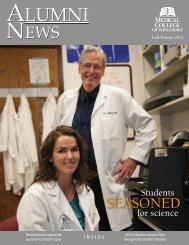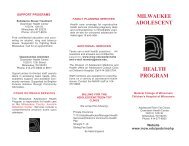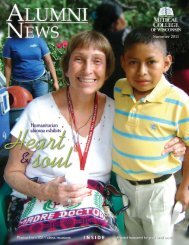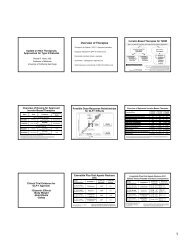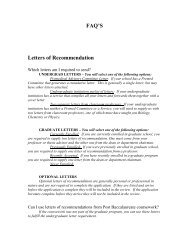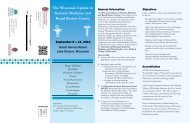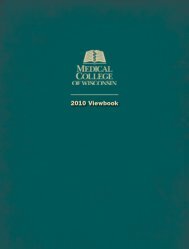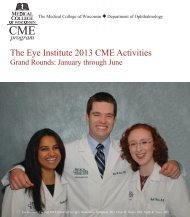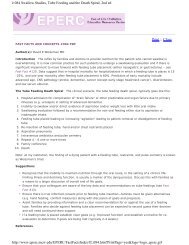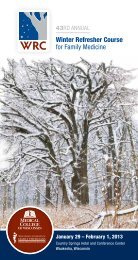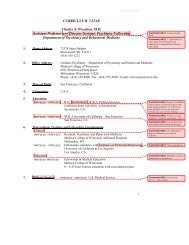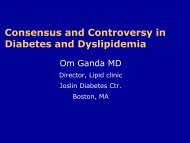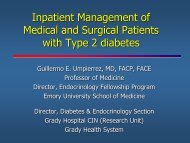Obesity & Lipodystrophy - Medical College of Wisconsin
Obesity & Lipodystrophy - Medical College of Wisconsin
Obesity & Lipodystrophy - Medical College of Wisconsin
Create successful ePaper yourself
Turn your PDF publications into a flip-book with our unique Google optimized e-Paper software.
Lipodystrophies<br />
Sixth Annual Diabetes Symposium <strong>of</strong> <strong>Wisconsin</strong><br />
May 17, 2013<br />
Abhimanyu Garg, M.D.<br />
Pr<strong>of</strong>essor <strong>of</strong> Internal Medicine<br />
Chief, Division <strong>of</strong> Nutrition and Metabolic Diseases<br />
Distinguished Chair in Human Nutrition Research<br />
UT Southwestern <strong>Medical</strong> Center
Disclosures<br />
Research support/ Speaker/ Consultant/Advisory Board<br />
For<br />
Amylin/ Bristol-Myers Squibb<br />
Merck<br />
Pfizer<br />
Aegerion
Lipodystrophies<br />
Disorders characterized by<br />
selective loss <strong>of</strong> adipose tissue.<br />
• Genetic<br />
• Acquired
Metabolic Complications <strong>of</strong><br />
Lipodystrophies<br />
• Insulin resistance, Premature DM<br />
• Hypertriglyceridemia, low HDL cholesterol<br />
• Polycystic ovarian syndrome<br />
• Acanthosis nigricans<br />
• Hepatic Steatosis<br />
• Hypertension (rare)
Acquired Lipodystrophies<br />
Generalized Partial HAART-induced<br />
(HIV-Patient)<br />
Localized
Genetic Lipodystrophies<br />
Autosomal Recessive<br />
• Congenital generalized<br />
lipodystrophy (CGL)<br />
• Mandibuloacral dysplasia<br />
(MAD)-associated<br />
• Autoinflammatory (JMP)<br />
• Other types<br />
– FPL<br />
– SHORT syndrome<br />
– Neonatal Progeroid<br />
syndrome<br />
– MDP syndrome<br />
Autosomal Dominant<br />
• Familial partial lipodystrophy<br />
(FPL)<br />
• Atypical progeroid<br />
syndrome<br />
• Hutchinson-Gilford progeria<br />
syndrome<br />
• SHORT syndrome
Congenital Generalized <strong>Lipodystrophy</strong><br />
(Berardinelli-Seip Syndrome)<br />
• Autosomal recessive<br />
• Prevalence < 1 in 10 million<br />
• Reported in ~300 patients <strong>of</strong><br />
various ethnicities
CGL Phenotype
Serum Leptin Levels in CGL<br />
5<br />
4<br />
~7 th %ile for M<br />
F<br />
Median<br />
Leptin (ng/mL)<br />
3<br />
2<br />
1<br />
0<br />
M F<br />
CGL1<br />
(APGAT2) (AGPAT2)<br />
M F<br />
CGL2<br />
(SEIPIN)<br />
Haque et al. JCEM 87:2395-8, 2002
Linkage <strong>of</strong> CGL1 locus to 9q34<br />
CG100<br />
CG300<br />
CG400<br />
CG600<br />
CG700<br />
D9S934<br />
LOD Score<br />
-4.0<br />
0.0<br />
-2.0 0.0 2.0 4.0 6.0<br />
1 2 3<br />
4 5<br />
1 2<br />
3 4 5 6 7 8 9<br />
1 2 3<br />
4 5 6<br />
1 2<br />
3 4 5 6 7<br />
D9S1825<br />
8.5<br />
HLOD17<br />
LOD15<br />
CG800<br />
CG900<br />
CG1000<br />
CG1100<br />
CG1300<br />
CG2800<br />
1 2<br />
3 4<br />
1 2 3<br />
4 6 7 8 9<br />
1 2<br />
3 4 5 6 7 8<br />
CG3100<br />
3 6<br />
9 10 11<br />
1 2<br />
3<br />
1 2<br />
3 4 5<br />
1 2<br />
3 4<br />
D9S915<br />
D9S2157<br />
D9S164<br />
D9S1793<br />
D9S1818<br />
17.2<br />
18.9<br />
19.9<br />
22.9<br />
21 22 23 24<br />
CG3300<br />
CG2900<br />
1 2<br />
CG3000<br />
1 2<br />
1 2<br />
CG3200<br />
1 2<br />
1 2 5<br />
3 4<br />
CG3500<br />
1 2<br />
D9S1826<br />
D9S158<br />
D9S1838<br />
D9S905<br />
31.6<br />
33.7<br />
35.9<br />
3 4 5 6 7<br />
3 4<br />
3 4 5 6<br />
3 4<br />
3 4 5 6<br />
D9S2168 41.0<br />
qTEL<br />
Garg et al. JCEM 84; 3390-4, 1999
D9S1818<br />
AGS3<br />
CARD9<br />
D9S1826<br />
SNAPC4<br />
PP15PIV<br />
LHX3<br />
D9S158<br />
NOTCH1<br />
AGPAT2<br />
EDF1<br />
D9S905<br />
DPP7<br />
PTGDS<br />
DPP7<br />
D9S1838<br />
Physical Map <strong>of</strong> 9q34 Region<br />
AGPAT2 Mutations in CGL, Type 1<br />
cen----<br />
TR<br />
TF<br />
(BAC 2521H7)<br />
---qtel<br />
L228P<br />
A239V<br />
G136R<br />
F140del L126fsX146<br />
V167fsX183 R68X<br />
3’<br />
5’<br />
6<br />
5<br />
4<br />
3<br />
2<br />
1<br />
916C>G<br />
-2A>C<br />
-2A>G<br />
Ex3-4del<br />
• Agarwal et al. Nat Genet 31: 21-23; 2002
AGPAT2 mutations in CGL, type 1<br />
(TG biosynthetic pathway)<br />
2-Monoacylglycerol<br />
H 2<br />
C<br />
HC<br />
OH<br />
OH<br />
GPAT<br />
H 2<br />
C<br />
HC<br />
O<br />
OH<br />
O<br />
C<br />
R 1<br />
AGPAT2<br />
mutated<br />
in CGL1<br />
AGPAT<br />
H 2<br />
C<br />
HC<br />
O<br />
O<br />
O<br />
C<br />
O<br />
C<br />
R 1<br />
R 2<br />
PP<br />
Acyl-CoA<br />
CoA<br />
H 2<br />
C<br />
HC<br />
O<br />
O<br />
MGAT<br />
O<br />
C<br />
O<br />
C<br />
R 1<br />
R 2<br />
DGAT<br />
H 2<br />
C<br />
HC<br />
O<br />
O<br />
O<br />
C<br />
O<br />
C<br />
O<br />
R 1<br />
R 2<br />
H 2<br />
C<br />
OPO 3<br />
2-<br />
Glycerol-<br />
3-Phosphate<br />
Acyl-<br />
CoA<br />
CoA<br />
H 2<br />
C<br />
OPO 3<br />
2-<br />
1-Acylglycerol-<br />
3-Phosphate<br />
(Lysophosphatidic Acid)<br />
Acyl-<br />
CoA<br />
CoA<br />
H 2<br />
C<br />
OPO 3<br />
2 -<br />
1,2 Diacylglycerol<br />
Phosphate<br />
(Phosphatidic Acid)<br />
H 2<br />
C<br />
O H<br />
H 2 O P i Acyl -<br />
CoA<br />
CoA<br />
H 2<br />
C<br />
1,2 Diacylglycerol Triacylglycerol<br />
O<br />
C<br />
R 3<br />
Phosphatidyl Inositol<br />
Cardiolipin<br />
Phosphatidyl Choline<br />
Phosphatidyl Ethanolamine<br />
Phosphatidyl Serine
mRNA Expression <strong>of</strong> AGPAT<br />
Is<strong>of</strong>orms in Human Tissues<br />
adipose tissue liver muscle<br />
- G3PDH<br />
]- AGPATs<br />
AGPAT<br />
1 2 3 4 5 1 2 3 4 5 1 2 3 4 5<br />
• Agarwal et al. Nat Genet 31: 21-23; 2002
MRI <strong>of</strong> Agpat2 -/- Mice<br />
Male<br />
Female<br />
WT Agpat2 -/- WT Agpat2 -/-<br />
Cortés et al. Cell Metab 9:165-176, 2009
Increased Lipid Staining in Livers <strong>of</strong><br />
Male Agpat2 -/- Mice<br />
Wild-type Agpat2 -/-<br />
A<br />
B<br />
H&E<br />
C<br />
D<br />
Oil Red O<br />
Cortés et al. Cell Metab 9:165-176, 2009
Wild Type<br />
Agpat2 -/-<br />
GLYCEROL- 3 - PHOSPHATE<br />
GLYCEROL- 3 - PHOSPHATE<br />
Fatty acid-CoA<br />
CoA<br />
GPATs<br />
Fatty acid-CoA<br />
CoA<br />
GPATs<br />
LYSOPHOSPHATIDIC<br />
ACID<br />
LYSOPHOSPHATIDIC<br />
ACID<br />
Fatty acid-CoA<br />
CoA<br />
AGPATs<br />
LPPs<br />
Fatty acid-CoA<br />
CoA<br />
AGPAT1,3-8<br />
AGPAT2<br />
PHOSPHATIDIC ACID<br />
PHOSPHATIDIC ACID<br />
2-MONOACYLGLYCEROL<br />
PAPs<br />
Fatty acid-<br />
CoA<br />
MGATs<br />
CoA<br />
DIACYLGLYCEROL<br />
2-MONOACYLGLYCEROL<br />
Fatty acid-<br />
CoA<br />
CoA<br />
MGATs<br />
PAPs<br />
DIACYLGLYCEROL<br />
Fatty acid-CoA<br />
CoA<br />
DGATs<br />
Fatty acid-CoA<br />
CoA<br />
DGATs<br />
Chylomicrons<br />
Chylomicrons<br />
TRIACYLGLYCEROL<br />
TRIACYLGLYCEROL<br />
Chylomicrons<br />
Remnant Receptor<br />
Chylomicrons<br />
Remnant Receptor<br />
Cortés et al. Cell Metab 9:165-176, 2009
Mechanism <strong>of</strong> Hepatic Insulin Resistance<br />
(Protein Expression)<br />
Cortés et al. Cell Metab 9:165-176, 2009
BSCL2 Mutations in CGL, Type 2<br />
• BSCL2 located on chromosome 11q13<br />
• Encodes a 462 amino acid transmembrane ER<br />
protein, seipin<br />
• Seipin has a CAAX motif at C-terminal and<br />
an N-glycosylation site<br />
• Role in lipid droplet formation and adipocyte<br />
differentiation<br />
• Magre et al. Nat Genet 2001;28:365-70<br />
• Windpassinger et al. Nat. Genet. 2004; 36:271-6<br />
• Agarwal & Garg. Trends Mol. Med. 2004;10:440-4<br />
Szymanski et al. PNAS 104:20890-20895, 2007<br />
Fei et al. J Cell Biol 180:473-482, 2008<br />
Payne et al. Diabetes 57:2055-2060, 2008
Lipid Droplet Formation and Seipin<br />
Nuclear pore<br />
Lipid droplet<br />
Glycerol-3-P<br />
FA-CoA<br />
GPATs<br />
CoA<br />
Nuclear pore<br />
Nucleus<br />
FA-CoA<br />
CoA<br />
LPA<br />
AGPATs<br />
Nucleus<br />
PA<br />
Pi<br />
PAPs<br />
ER<br />
FA-CoA<br />
CoA<br />
DAG<br />
TG<br />
DGATs<br />
ER<br />
Lipid droplet<br />
fusion<br />
Normal<br />
Seipin Deficiency<br />
Garg and Agarwal. BBA: 1791:507-13. 2009
Phenotypic Differences in CGL Patients<br />
Mental Retardation<br />
Cardiomyopathy<br />
Lytic bone lesions<br />
Loss <strong>of</strong> Mechanical Fat<br />
Metabolic Abnormalities<br />
CGL1<br />
(AGPAT2)<br />
–<br />
–<br />
++<br />
–<br />
+++<br />
CGL2<br />
(BSCL2)<br />
+<br />
+<br />
–<br />
++<br />
+++<br />
• Magre´ J, et al. Nat Genet 2001;28:365-70<br />
• Agarwal, Simha et al. JCEM 2003; 88:4840-47<br />
• van Meldergem et al. J Hum Genet 2003;39:722-33
CGL1<br />
(AGPAT2)<br />
CGL2<br />
(BSCL2)<br />
C<br />
Normal<br />
• Simha & Garg. JCEM 88: 5433-7, 2003
CGL1<br />
(AGPAT2)<br />
CGL2<br />
(BSCL2)<br />
Normal<br />
• Simha & Garg. JCEM 88: 5433-7, 2003
CGL1<br />
(AGPAT2)<br />
CGL2<br />
(BSCL2)<br />
C<br />
Normal<br />
• Simha & Garg. JCEM 88: 5433-7, 2003
Caveolin 1 mutation in CGL, Type 3<br />
Caveolae<br />
Nuclear pore<br />
PTRF/Cavin Caveolin-1<br />
Nucleus<br />
Caveolin<br />
vesicle<br />
Perilipin<br />
ER<br />
Lipid droplet<br />
CIDEC<br />
8.8 y 20 y<br />
Kim, CA et al. JCEM 2008;93:1129-1134<br />
Garg and Agarwal, JCEM 2008;93:1183-1185
Novel CGL, type 4<br />
CG7100<br />
• Two affected siblings<br />
• Congenital myopathy<br />
• Muscle Bx: Non-specific<br />
• Elevated CK levels<br />
• Atlantoaxial instability<br />
Simha et al. Am J Med Genet.146A:2318-26, 2008.
Polymerase I and transcript release factor (PTRF) mutations in CGL4<br />
PTRF/Cavin<br />
Hayashi et al. J Clin Invest 119: 2623-33; 2009.
Amplitude (µV)<br />
50µV<br />
CGL, Type 4<br />
A<br />
(Additional Phenotypic Features)<br />
A.<br />
• Percussion induced muscle mounding D<br />
• Congenital pyloric stenosis<br />
• Long QT interval<br />
B.<br />
• Predisposition to arrhythmias/sudden death<br />
• Catecholaminergic polymorphic ventricular<br />
C.<br />
tachycardia<br />
30ms<br />
Time (ms)<br />
Hayashi et al. J Clin Invest 119: 2623-33; 2009.<br />
Shastry et al. Am J Med Genet 2010;152A:2245-53.<br />
Rajab et al. Plos Genet 2010;6:e1000874.
Congenital Generalized <strong>Lipodystrophy</strong><br />
(Our Experience)<br />
• 118 Pedigrees genotyped<br />
• AGPAT2 mutations: 67<br />
• BSCL2 mutations: 32<br />
• CAV1 mutation: 0<br />
• PTRF mutations: 3<br />
• Unexplained: 16
Familial Partial <strong>Lipodystrophy</strong><br />
(Dunnigan type)<br />
• Autosomal dominant<br />
• Prevalence < 1 in 10 million<br />
• Described in ~ 300 patients<br />
mainly <strong>of</strong> European ancestry
Familial Partial <strong>Lipodystrophy</strong>, Dunnigan type<br />
Female<br />
Male
Haque et al. JCEM 87: 2395-2398, 2002<br />
Serum Leptin Levels in FPL, Dunnigan<br />
60<br />
Males<br />
Females<br />
55<br />
~7 th %ile for M<br />
F<br />
Leptin (ng/mL)<br />
10<br />
5<br />
0<br />
15 20 25 30 35 40<br />
BMI (kg/m 2 )
F200<br />
1 2<br />
FPLD Pedigrees<br />
F300<br />
F500<br />
1 2 3<br />
3 4 5 6 7 8 9 10 11 12<br />
1 2<br />
4 5 6 7 8 9 10<br />
3 4 5 6 7 8<br />
11 12 13 14 15<br />
13 14 15 16 17 18 19 20 21 22 23 24 25<br />
9 10 11 12 13 14<br />
16 17 18 19 20 21 22<br />
F600<br />
1 2<br />
26 27 28<br />
F700<br />
1 2<br />
23 24 25 26<br />
3 4 5 6 7 8 9 10<br />
3 4 5 6 7 8 9 10 11<br />
11 12 13 14 15 16 17 18 19 20 21 22<br />
12 13 14 15 16 17 18 19 20 21 22 23<br />
24 25 26 27 28 29 30 31 32 33 34 35 36 37 38 39 40 41 42 43 44 45 46 47 48 49<br />
23 24 25 26 27 28 29 30 31 32 33 34<br />
50 51 52 53 54 55 56 57 58 59 60 61 62 63 64 65 66 67 68 69 70 71 72 73<br />
Peters et al. Nat Genet 18: 292-5, 1998
FPLD Locus on Chromosome 1q21-22<br />
Loci<br />
D1S1631<br />
cM<br />
0.0<br />
-6.0<br />
LOD Score<br />
-4.0 -2.0 0.0 2.0 4.0 6.0 8.0<br />
D1S534<br />
Cen<br />
D1S442<br />
D1S305<br />
D1S2721<br />
D1S2624<br />
D1S1600<br />
D1S1653<br />
D1S1167<br />
Apo AII<br />
D1S1679<br />
D1S1677<br />
15.6<br />
18.3<br />
22.4<br />
23.6<br />
25.6<br />
27.7<br />
29.2<br />
33.3<br />
34.8<br />
35.4<br />
39.3<br />
D1S518<br />
66.3<br />
Peters et al. Nat Genet<br />
18: 292-5, 1998
Lamin A/C Mutations in FPLD<br />
16kb<br />
2kb<br />
5' // // // 3'<br />
1 2 3 4 5 6 7 8 9 10 11 12<br />
R482Q<br />
* Cardiomyopathy<br />
† Emery-Dreifuss Muscular Dystrophy<br />
‡ Limb Girdle Muscular Dystrophy<br />
§ Mild Myopathy<br />
Mild <strong>Lipodystrophy</strong><br />
Cao and Hegele. Hum Mol Genet 9:109-112, 2002<br />
Garg A. N Engl J Med 350; 1220-34, 2004
Structure <strong>of</strong> Nuclear Lamina<br />
• Garg A. N Engl J Med 2004:350; 1220-34.
Pathogenesis <strong>of</strong> lipodystrophy in FPLD<br />
patients<br />
• LMNA mutations induce nuclear<br />
dysfunction resulting in premature death<br />
or apoptosis <strong>of</strong> adipocytes<br />
• Why fat loss spares the face, neck and<br />
intra-abdominal region?
Familial Partial <strong>Lipodystrophy</strong><br />
PPARG Mutation<br />
FPL Normal<br />
Arm<br />
Forearm<br />
Thigh<br />
Calf<br />
Agarwal &<br />
Garg.<br />
JCEM 2002;<br />
87: 408-11
PPARG Mutations in FPL<br />
Agarwal & Garg. JCEM 2002; 87: 408-11<br />
Hegele et al. Diabetes 2002;51:3586-90<br />
Savage et al. Diabetes 2003; 52:910-17<br />
Garg A. N Engl J Med 350; 1220-34, 2004
Phenotypic Differences in FPL Patients<br />
Peripheral Fat Loss<br />
Fat excess in Face/Neck<br />
Cardiomyopathy<br />
Hypertension<br />
Onset <strong>of</strong> <strong>Lipodystrophy</strong><br />
FPLD2<br />
(LMNA)<br />
+++<br />
+++<br />
+<br />
+/-<br />
Puberty<br />
FPLD3<br />
(PPARG)<br />
+/++<br />
-/+<br />
-<br />
++<br />
Variable
FPL: AKT2 gene<br />
(v-akt murine thymoma viral oncogene homolog 2)<br />
PI-dependent Ser-Thr protein kinase<br />
• R274H heterozygous<br />
mutation in a pedigree with<br />
lipodystrophy, DM and<br />
insulin resistance<br />
Courtesy <strong>of</strong> Stephen O’Rahilly<br />
George S, et al. Science 304; 1325-28, 2004<br />
Agarwal & Garg. Ann Rev Genomics Human Genet 7: 175-199, 2006.
CIDEC mutation in autosomal<br />
recessive FPL<br />
Perilipin Staining<br />
Patient<br />
Control<br />
Vessels<br />
Rubio-Cabezas et al. EMBO Mol Med 1: 280-287, 2009
FPL, PLIN1 Mutations<br />
Gandotra et al. NEJM 364, 740-8; 2011
Familial Partial <strong>Lipodystrophy</strong><br />
(Our Experience)<br />
• 241 Pedigrees genotyped<br />
• LMNA mutations: 92<br />
• PPARG mutations: 5<br />
• PLIN1 mutation: 0<br />
• AKT2 mutations: 0<br />
• CIDEC mutation: 0<br />
• Unexplained: 144
Familial Partial <strong>Lipodystrophy</strong>, Other Type
Thigh<br />
Calf<br />
Heterogeneity in FPL phenotype (Whole body MRI)<br />
FPL (other type)<br />
FPL (Dunnigan) FPL (PPARG)<br />
Normal<br />
FPL (other type)<br />
FPL (Dunnigan) FPL (PPARG)<br />
Normal<br />
D
FPL 122
FPL 122<br />
F122<br />
1<br />
2<br />
4 5 6 7<br />
3 10 8<br />
9<br />
11<br />
12<br />
13<br />
15<br />
16<br />
14<br />
* Exome Sequencing
FPL 122<br />
• Exome sequencing 3 persons<br />
• Filters:<br />
• Linkage region<br />
• Functional variants<br />
• Not in 1000G and dbSNP<br />
• 5 variants left- 3 novel<br />
• One <strong>of</strong> them highly expressed in adipose<br />
tissue (Good candidate)
Familial Partial <strong>Lipodystrophy</strong><br />
(Future Directions)<br />
• Detailed phenotyping <strong>of</strong> PPARG, AKT2,<br />
CIDEC and PLIN1 subtypes<br />
• Search for additional loci<br />
• Understanding role <strong>of</strong> lamin A/C in adipocyte<br />
survival<br />
• Understanding additional pathways involved in<br />
lipodystrophy-induced insulin resistance
MAD associated <strong>Lipodystrophy</strong> and Progeroid<br />
Syndrome<br />
(LMNA homozygous Arg527His mutation)<br />
• 20-year-old Hispanic<br />
female<br />
• Beaked nose, small<br />
mouth<br />
• Bird-like faces<br />
• Contractures <strong>of</strong> 5 th<br />
fingers<br />
• Skin atrophy and loss <strong>of</strong><br />
SC fat from dorsum <strong>of</strong><br />
hands<br />
SImha & Garg. JCEM 87; 776-85, 2002<br />
Simha et al. JCEM 88: 2821-2824, 2003
MAD associated <strong>Lipodystrophy</strong> and<br />
Progeroid Syndrome<br />
LMNA Hom R527C<br />
LMNA Hom R527H<br />
Patient<br />
Control<br />
Agarwal et al. JCEM 2008;93:4617-23.
MAD associated <strong>Lipodystrophy</strong> and<br />
Progeroid Syndrome<br />
(Compound heterozygous ZMPSTE24 mutations)<br />
Age 2<br />
Age 18<br />
• Skin atrophy and<br />
contractures - age 2<br />
• Pinched nose<br />
• Skin contractures around<br />
interphalangeal joints<br />
• Sparse, brittle, grey hair<br />
• Generalized lipodystrophy<br />
• Died at age 24 from focal<br />
segmental glomerulosclerosis<br />
(FSGS)<br />
•Agarwal et al. Hum Mol Genet 2003;12:1195-2001
Post-translational Modification <strong>of</strong><br />
Lamin A<br />
Michaelis & Hrycyna. Science 2013; 339: 1529-30.<br />
WT<br />
FT<br />
Lamin<br />
Lamin A/C<br />
A<br />
C<br />
•Shackleton et al. J Med Genet 42: e36, 2005
MAD-associated <strong>Lipodystrophy</strong><br />
(Our Experience)<br />
• 26 Pedigrees genotyped<br />
• LMNA mutations: 16<br />
• ZMPSTE24 mutations: 5<br />
• Unexplained: 5
Mandibular Hypoplasia, Deafness and Progeroid<br />
(MDP) Syndrome<br />
Shastry et al. JCEM 2010;95:E192-7.
Mandibular Hypoplasia, Deafness and Progeroid<br />
(MDP) Syndrome<br />
Clinical Feature<br />
MAD (LMNA)<br />
n=28<br />
MAD (ZMPSTE24)<br />
n=8<br />
Mandibular hypoplasia + + +<br />
Sclerodermatous skin + + +<br />
MDP<br />
n=7<br />
<strong>Lipodystrophy</strong> Partial Partial Partial/generalized<br />
Clavicular hypoplasia + + -<br />
Acro-osteolysis + + -<br />
Deafness - - +<br />
Undescended testes,<br />
male hypogonadism<br />
- - +<br />
Shastry et al. JCEM 2010;95:E192-7.
Hutchinson-Gilford Progeria Syndrome<br />
(LMNA p.G608G Het Mutation)<br />
Progeria at 19, 2 and 7 years <strong>of</strong> age<br />
Photo provided by The Progeria Research Foundation<br />
www.progeriaresearch.org
Atypical Progeroid Syndrome<br />
(LMNA Heterozygous Mutations)<br />
P4R<br />
E159K D136H C588R P4R<br />
C588R
Joint Contractures, Microcytic Anemia, and Panniculitis-induced<br />
(JMP) <strong>Lipodystrophy</strong><br />
Garg et al. JCEM 2010; 95:E58-63<br />
JMP100<br />
1 2<br />
3<br />
4<br />
JMP200<br />
1 2<br />
5 6 7<br />
8 3 4<br />
9
31.5 Mb<br />
B Allele Frequency<br />
0.0 0.5 1.0 0.0 0.5 1.0 0.0 0.5 1.0<br />
32.0 Mb<br />
32.5 Mb<br />
33.0 Mb<br />
33.5 Mb<br />
JMP200.4<br />
JMP200.3<br />
JMP100.3<br />
34.0 Mb<br />
F.U. / μg protein<br />
Agarwal et al. AJHG 2010;87:866-72.<br />
20S<br />
PA700<br />
Control<br />
JMP200.4<br />
Figure 1<br />
A<br />
PSMB8 mutation in JMP syndrome<br />
Figure 2<br />
A<br />
B<br />
Gly119<br />
6.4 Å<br />
Human 69 MAHGTTTLAFKFQHGVI<br />
Chimpanzee 69 MAHGTTTLAFKFQHGVI<br />
Dog 69 MVHGTTTLAFKFQHGVI<br />
Cow 69 MAHGTTTLAFKFQHGVI<br />
Mouse 69 MAHGTTTLAFKFQHGVI<br />
Zebrafish 64 LNHGTTTLAFKFRHGVI<br />
Thr73<br />
Gly119<br />
7.6 Å<br />
Thr73<br />
Thr75<br />
Met75<br />
B<br />
Chr 6 25.0 30.0 35.0 40.0 Mb<br />
Tel<br />
5’<br />
3’<br />
3’ 5’<br />
Cent<br />
PSMB8 (wild-type)<br />
Mutant PSMB8 (Thr75Met)<br />
C<br />
5’<br />
3’<br />
1A 1B 2 3 4 5 6<br />
3’ 5’<br />
D Wild Type E het224C>T F<br />
3’<br />
5’<br />
hom224C>T<br />
C<br />
10000<br />
9000<br />
8000<br />
7000<br />
6000<br />
5000<br />
4000<br />
3000<br />
2000<br />
1000<br />
0<br />
p=0.02<br />
p=0.11<br />
Control<br />
JMP200.4<br />
p=0.21<br />
D<br />
Lymphoblast<br />
┌────────┐<br />
Rpt2<br />
Rpn12<br />
2<br />
5i<br />
5<br />
A C C A C G C<br />
Thr<br />
74<br />
Thr<br />
75<br />
T<br />
Leu<br />
76<br />
C<br />
A<br />
C C A N G C T C<br />
Thr<br />
74<br />
Thr/Met<br />
75<br />
Leu<br />
76<br />
A<br />
C C A T G C T C<br />
Thr<br />
74<br />
Met<br />
75<br />
Leu<br />
76<br />
Proteasomal Activity<br />
actin
SHORT Syndrome<br />
Autosomal dominant (n=4) and recessive (n=11)<br />
• Short stature<br />
• Hyperextensibility <strong>of</strong><br />
joints<br />
• Ocular depression<br />
• Rieger anomaly<br />
• Teething delay<br />
• Premature onset <strong>of</strong> DM<br />
• <strong>Lipodystrophy</strong><br />
AD, type 1 AD, type 2
SHORT 1100<br />
Photos from Dr. Al-Gazali, UAE
SHORT 1100<br />
1 2<br />
3<br />
4 5 6 7
SHORT 1100<br />
• Exome sequencing 3 affected subjects<br />
• Filters:<br />
• Linkage region<br />
• Functional variants<br />
• Not in 1000G and dbSNP<br />
• 5 variants left (none in Seattle Exome Project)<br />
• One <strong>of</strong> them is a good candidate
Neonatal Progeroid Syndrome<br />
(Wiedemann-Rautenstrauch)<br />
• Premature birth<br />
• Oligoohydroamnios and IUGR<br />
• Dry, deeply wrinkled skin<br />
• Large, low set ears, and beaked nose<br />
• Generalized loss <strong>of</strong> SC fat sparing gluteal region<br />
• Normal glucose and lipids<br />
• 25 patients reported, early death
NPS 100.3<br />
O’Neill, Simha, et al. AJMG 143A:1421-30, 2007
Neonatal Progeroid Syndrome<br />
(Wiedemann-Rautenstrauch)
Lipodystrophies<br />
Disorders <strong>of</strong> Adipose Tissue Development, Differentiation and Death<br />
Development Differentiation Death/Apoptosis<br />
Interstitial tissue<br />
(PSMB8)<br />
Myocytes<br />
Osteoblasts<br />
Transcription<br />
factors?<br />
Adipogenic factors<br />
(Insulin, cortisol, etc.)<br />
C/EBPβ<br />
C/EBPδ<br />
C/EBPα<br />
SREBP1c<br />
PPARγ / RXRα<br />
Lipogenesis<br />
(FAS, ACC,<br />
GPAT, AGPAT, DGAT)<br />
Apoptosis<br />
(Lamin A/C,<br />
ZMPSTE24)<br />
Feeding<br />
Seipin/AKT2<br />
Fasting<br />
Mesenchymal<br />
Stem cells<br />
Pre-adipocyte<br />
Adipocyte Mature adipocyte Cell Death<br />
Garg. JCEM 2011;96:3313-25
Lipodystrophies<br />
Disorders <strong>of</strong> Lipid Droplet Formation<br />
Caveolae<br />
Nucleus<br />
Lamin A/C<br />
(ZMPSTE24)<br />
Caveolin-1<br />
(PTRF)<br />
Caveolin<br />
vesicle<br />
Nuclear<br />
Lamina<br />
ER<br />
FA-CoA<br />
CoA<br />
Glycerol-3-P<br />
LPA<br />
FA-CoA<br />
CoA AGPATs<br />
Pi<br />
PA<br />
Lipid droplet<br />
DAG<br />
MGATs<br />
FA-CoA<br />
CoA<br />
DGATs<br />
TG<br />
GPATs<br />
PAPs<br />
CoA FA-CoA<br />
MAG<br />
CIDEC<br />
Perilipin1<br />
Seipin<br />
Garg. JCEM 2011;96:3313-25
Leptin Therapy in Patients with<br />
<strong>Lipodystrophy</strong><br />
• 9 Females<br />
- 5 Congenital Generalized <strong>Lipodystrophy</strong><br />
- 3 Acquired Generalized <strong>Lipodystrophy</strong><br />
- 1 Familial Partial <strong>Lipodystrophy</strong><br />
• 2 Sites<br />
- NIH - UT Southwestern<br />
• Oral EA et al. NEJM 346:570-8; 2002
Hypoglycemic Therapy During Leptin Study<br />
Patient baseline period 4mo <strong>of</strong> leptin therapy<br />
NIH-1<br />
Metformin (500mg bid)<br />
Acarbose (50mg tid)<br />
None<br />
NIH-2<br />
NIH-3<br />
NIH-4<br />
NIH-5<br />
NIH-6<br />
NIH-7<br />
UTSW-1<br />
Insulin (800 U/day)<br />
Insulin (40 U/day)<br />
Metformin (500mg tid)<br />
Insulin (1200 U/day)<br />
Insulin (3000 U/day)<br />
Metformin (500mg tid)<br />
Insulin (200 U/day)<br />
Pioglitazone (45mg qd)<br />
Insulin (700 U/day)<br />
None<br />
None<br />
None<br />
None<br />
None<br />
Insulin (60 U/day)<br />
Insulin (300 U/day)<br />
UTSW-2 1 None<br />
None<br />
1<br />
Nondiabetic patient • Oral EA et al. NEJM 346:570-8; 2002
-<br />
Leptin Therapy in Patients with <strong>Lipodystrophy</strong><br />
Leptin Dose<br />
(% Replacement)<br />
200<br />
100<br />
0<br />
16<br />
‡<br />
Leptin<br />
(ng/mL)<br />
12<br />
8<br />
4<br />
*<br />
0<br />
1000<br />
Triglycerides<br />
(mg/dL)<br />
800<br />
600<br />
400<br />
*<br />
‡ ‡<br />
200<br />
0<br />
0 1 2 3 4<br />
Study Period (months)<br />
• Oral EA et al. NEJM 346:570-8; 2002
-<br />
Leptin Therapy in Patients with <strong>Lipodystrophy</strong><br />
Leptin Dose<br />
(% Replacement)<br />
Glucose<br />
(mg/dL)<br />
200<br />
100<br />
0<br />
220<br />
200<br />
180<br />
160<br />
140<br />
120<br />
100<br />
80<br />
10<br />
‡<br />
Hemoglobin A1c<br />
(%)<br />
9<br />
8<br />
7<br />
‡<br />
‡ ‡<br />
6<br />
0 1 2 3 4<br />
Study Period (months)<br />
• Oral EA et al. NEJM 346:570-8; 2002
Acknowledgments<br />
Genetics<br />
• Anil Agarwal, Ph.D.<br />
• Robert Barnes, M.S.<br />
• Anne Bowcock, Ph.D.<br />
• John Peters, B.S.<br />
• Lynda Bennett, Ph.D.<br />
• William Gitomer, Ph.D.<br />
• Chao Xing, Ph.D.<br />
Radiology<br />
• Ronald Peshock, M.D.<br />
• James Fleckenstein, M.D.<br />
• Paul Weatherall, M.D.
Acknowledgments<br />
Center for Human Nutrition<br />
• Dali Chen, M.D.<br />
• Wasim Haque, M.D.<br />
• Anoop Misra, M.D.<br />
• Lalitha Subramanyam, MD<br />
• Asha Prakash, M.D. • Vinaya Simha, M.D.<br />
• Maheswari Vinai, M.D. • Claudia Quittner<br />
• Hamsa Gangaswamiah, M.D. • Hongzhao Ji<br />
• Aparna Peethambaram, M.D. • Savitha Shastry, M.D.<br />
• Darshana Purohit, M.D. • Zahid Ahmad, M.D.<br />
• Aliya Heyliger, M.D. • Scott Grundy, M.D., Ph.D.
Acknowledgments<br />
Many National and International Collaborators<br />
Patients and Their Families<br />
FPL CGL MAD FPLX MDP WRS SHORT APS<br />
APL<br />
AGL<br />
Financial Support from NIDDK and NCRR
For More Information visit:<br />
FPL CGL MAD FPLX MDP WRS SHORT APS<br />
APL<br />
AGL<br />
www.lipodystrophy.info



